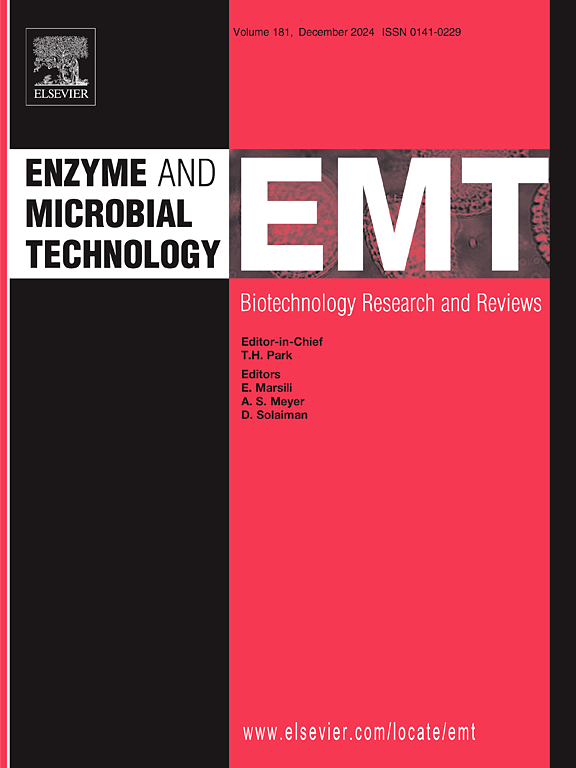Peptidases production by Sordariomycetes sp fungus from Manihot esculenta Crantz waste: Application in gluten hydrolysis
IF 3.7
3区 生物学
Q2 BIOTECHNOLOGY & APPLIED MICROBIOLOGY
引用次数: 0
Abstract
With the increasing incidence of problems related to gluten intolerance, many studies are being conducted to develop effective treatments and alternatives for gluten digestion. In this context, this study investigated peptidases produced by endophytic fungi isolated from cassava residues capable of hydrolyzing gluten. Twelve fungi were isolated, identified via DNA sequencing, and evaluated for their potential to produce peptidases with this potential. Sordariomycetes sp. (ST15) presented the highest specific peptidase activity to hydrolyze gluten, determined via fluorescence spectroscopy. Therefore, this fungus was selected to perform the optimization step of producing this peptidase. A composite rotational design with a central point (DCCR) was used to evaluate the influence of pH, temperature, and time on fermentation. The ideal conditions for producing the peptidase of interest were pH 5.2, 27 °C, and 11 days. According to the profile obtained via HPLC, the peptidase-enriched extract demonstrated significant gluten hydrolysis potential, efficiently breaking down gliadin and glutenin proteins within two hours of reaction. These findings highlight the potential of ST15 peptidase as a biocatalyst for gluten hydrolysis, offering a promising alternative for controlling gluten intolerance.
sordariomyetes sp fungus从manhot esculenta Crantz废弃物中生产肽酶:在面筋水解中的应用
随着与麸质不耐症相关的问题的发生率越来越高,人们正在进行许多研究,以开发有效的治疗和替代麸质消化。在此背景下,本研究研究了从木薯残基中分离的内生真菌产生的能够水解面筋的肽酶。分离出12种真菌,通过DNA测序进行鉴定,并评估其产生具有这种潜力的肽酶的潜力。通过荧光光谱测定,sordariomyetes sp. (ST15)水解谷蛋白的特异性肽酶活性最高。因此,选择该真菌进行生产该肽酶的优化步骤。采用带中心点的复合旋转设计(DCCR)来评价pH、温度和时间对发酵的影响。产生目标肽酶的理想条件为pH 5.2, 27 °C, 11天。根据HPLC获得的图谱,富含肽酶的提取物显示出明显的谷蛋白水解潜力,在反应的两小时内有效地分解麦胶蛋白和谷蛋白。这些发现突出了ST15肽酶作为谷蛋白水解生物催化剂的潜力,为控制谷蛋白不耐症提供了一种有希望的替代方法。
本文章由计算机程序翻译,如有差异,请以英文原文为准。
求助全文
约1分钟内获得全文
求助全文
来源期刊

Enzyme and Microbial Technology
生物-生物工程与应用微生物
CiteScore
7.60
自引率
5.90%
发文量
142
审稿时长
38 days
期刊介绍:
Enzyme and Microbial Technology is an international, peer-reviewed journal publishing original research and reviews, of biotechnological significance and novelty, on basic and applied aspects of the science and technology of processes involving the use of enzymes, micro-organisms, animal cells and plant cells.
We especially encourage submissions on:
Biocatalysis and the use of Directed Evolution in Synthetic Biology and Biotechnology
Biotechnological Production of New Bioactive Molecules, Biomaterials, Biopharmaceuticals, and Biofuels
New Imaging Techniques and Biosensors, especially as applicable to Healthcare and Systems Biology
New Biotechnological Approaches in Genomics, Proteomics and Metabolomics
Metabolic Engineering, Biomolecular Engineering and Nanobiotechnology
Manuscripts which report isolation, purification, immobilization or utilization of organisms or enzymes which are already well-described in the literature are not suitable for publication in EMT, unless their primary purpose is to report significant new findings or approaches which are of broad biotechnological importance. Similarly, manuscripts which report optimization studies on well-established processes are inappropriate. EMT does not accept papers dealing with mathematical modeling unless they report significant, new experimental data.
 求助内容:
求助内容: 应助结果提醒方式:
应助结果提醒方式:


